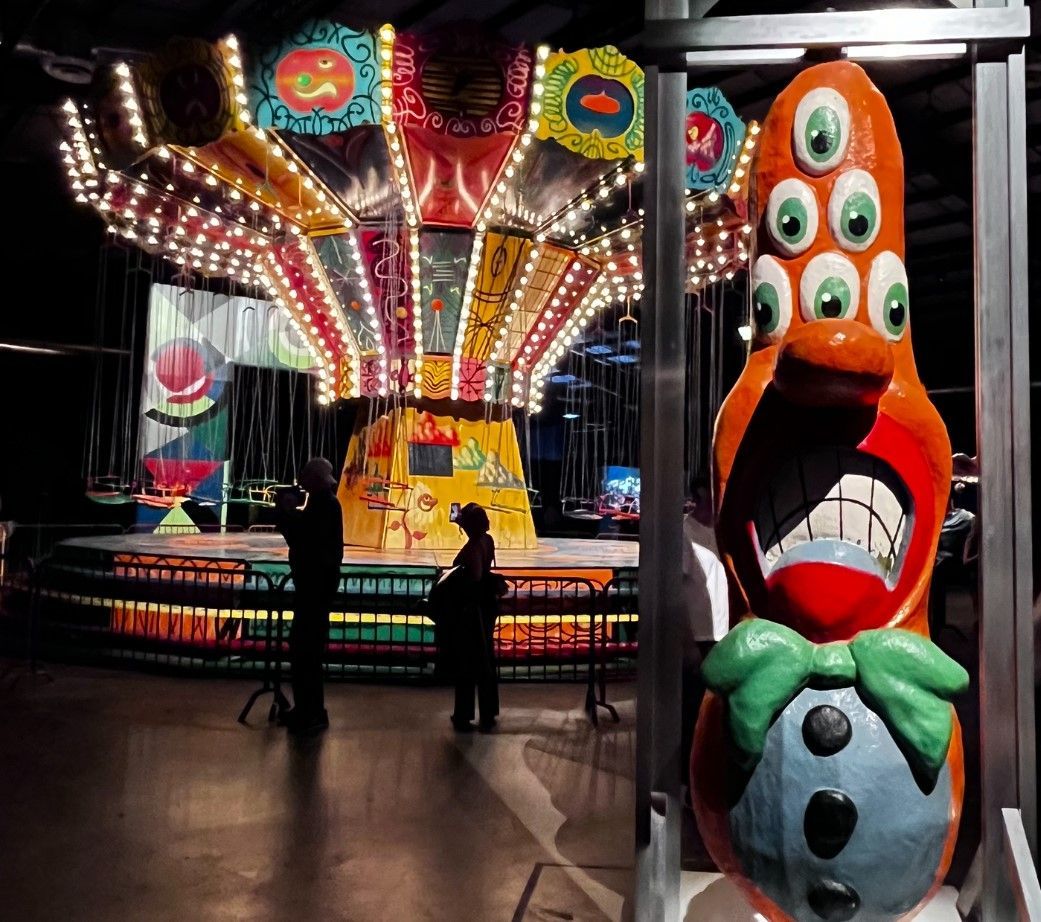Theme Park or Museum?
Jack Skelley tours Luna Luna, an art theme park recently resurrected by Drake, containing work by Basquiat, Haring, and others.
By Jack SkelleyJanuary 6, 2024

LUNA LUNA: FORGOTTEN FANTASY, Los Angeles, through January 2024.
Contemporary art and amusement parks have much to say to each other. For sure, in our post-structuralist, intertextual age, the theme park and art industries have separately evolved the mechanisms of “amusement,” overlapping in the concept of the interactive art installation.
Michael C. McMillen’s famous 1981 assemblage Central Meridian (in the Los Angeles County Museum of Art) is a moody, immersive, walk-through meditation on memory. The late artist Sturtevant created a classic dark ride, The House of Horrors (Le Train Fantôme), for Musée d’Art Moderne de Paris in 2010, with heavy geopolitical overtones (including references to Abu Ghraib). And you could say that Paul McCarthy’s career-long oeuvre is a sick roast of Disney and Disneyland, including his wild, assaultive, warehouse-sized WS White Snow, which freaked out last year’s Frieze Los Angeles.
In all these cases, art captures the concept of attraction—of desire and taboo—in sophisticated, poetic ways that mirror rides and theme parks.
Luna Luna: Forgotten Fantasy does not. It says much about the financial mechanics of the art world, and little about art as a simulation of psychic experiences. Rather than commission artists to transport the senses, it very literally reassembles its 1987 Hamburg incarnation with the artists who went on to become superstars, including Jean-Michel Basquiat, Keith Haring, Roy Lichtenstein, Salvador Dalí, David Hockney, Kenny Scharf, Roland Topor, Jean Tinguely, and Sonia Delaunay.
There is almost zero public interaction with the art pieces. As a common complaint goes, “You can’t ride the rides!” Even those installations that permit limited interaction feel off-limits. Dalí’s Dalídom, for example, is a Pepto Bismol–colored geodesic dome with mirrored interior that’s visually stunning. But Luna Luna forbids taking your own photos inside it; you can have an attendant take shots on your camera, however.
Periodically throughout your visit, the carnivalesque Philip Glass soundtrack will crescendo, and the lighting will focus on one attraction. Hockney’s Enchanted Tree takes the form of a circular room you can walk inside, painted in classic Hockney shades of red, black, green, and blue. The effect is anticlimactic. Even more frustrating, this and the Dalí experience are reserved for “Moon Pass” VIP ticket holders only—$85. Regular admission runs from $20 (youths) to $47 (weekends).
As a result, although gamely enlivened with strolling performers, the entire encounter feels frozen under glass. The “rides” are more untouchable kinetic sculptures than guest experiences (to use the Disney term). Thankfully, however, the original Hamburg production was thoroughly documented. It is re-displayed here on a compelling art-historical level. (I loved the old videos of pop artist Scharf in action, spray-painting the panels on his swing ride.)
As for the admission prices, I imagine securing and coordinating with the estates of these legacy artists and the collector/museum-industrial complex was not cheap. Drake reportedly chipped in $100 million for the enterprise. In addition to being a musical performer, he is now also an art collector. And that tells you all you need to know about the inner workings of Luna Luna.
¤
Photo by contributor.
LARB Short Take live event reviews are published in partnership with the nonprofit Online Journalism Project and the Independent Review Crew.
LARB Contributor
Jack Skelley is the author of the novel The Complete Fear of Kathy Acker (Semiotext(e), 2023), and Myth Lab: Theories of Plastic Love (Far West Press, 2024). Jack’s other books include Monsters (Little Caesar Press, 1982), Dennis Wilson and Charlie Manson (Fred & Barney Press, 2021), and Interstellar Theme Park: New and Selected Writing (BlazeVOX, 2022). Jack’s psychedelic surf band Lawndale released two albums on SST Records, and has a new album, Twango.
Did you know LARB is a reader-supported nonprofit?
LARB publishes daily without a paywall as part of our mission to make rigorous, incisive, and engaging writing on every aspect of literature, culture, and the arts freely accessible to the public. Help us continue this work with your tax-deductible donation today!